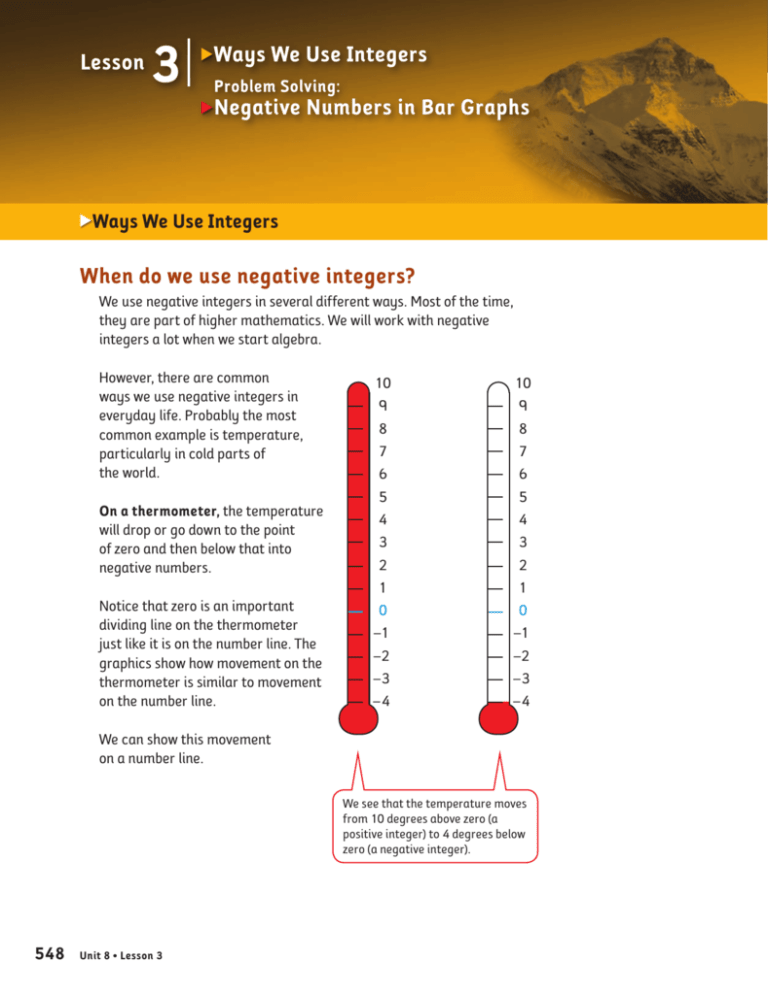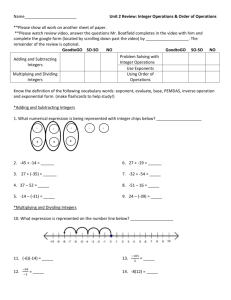
Lesson
3 Ways We Use Integers
Problem Solving:
Negative Numbers in Bar Graphs
Ways We Use Integers
When do we use negative integers?
We use negative integers in several different ways. Most of the time,
they are part of higher mathematics. We will work with negative
integers a lot when we start algebra.
However, there are common
ways we use negative integers in
everyday life. Probably the most
common example is temperature,
particularly in cold parts of
the world.
On a thermometer, the temperature
will drop or go down to the point
of zero and then below that into
negative numbers.
Notice that zero is an important
dividing line on the thermometer
just like it is on the number line. The
graphics show how movement on the
thermometer is similar to movement
on the number line.
10
9
8
7
6
5
4
3
2
1
0
–1
–2
–3
–4
10
9
8
7
6
5
4
3
2
1
0
–1
–2
–3
–4
We can show this movement
on a number line.
We see that the temperature moves
from 10 degrees above zero (a
positive integer) to 4 degrees below
zero (a negative integer).
548 Unit 8 • Lesson 3
Lesson 3
Example 1
Use a number line to show the temperature changing from 10 degrees
to −4 degrees.
−14 degrees
−4
−3
−2
−1
0
1
2
3
4
5
6
7
8
9
10
The temperature changed 14 degrees.
Improve Your Skills
Your friend wants to know how much the temperature changed from morning
to afternoon. In the morning, the temperature was −5 degrees. Later that
afternoon, the temperature was 22 degrees.
Your friend says that the temperature increased 17 degrees from morning to
afternoon. ERROR
When we look at this problem on a number line, we see the answer.
27 degrees
−6 −5 −4 −3 −2 −1 0 1 2 3 4 5 6 7 8 9 10 11 12 13 14 15 16 17 18 19 20 21 22 23
Your friend started counting at 5. He should have started at −5.
The temperature increased 27 degrees from morning to afternoon. CORRECT
Unit 8 • Lesson 3 549
Lesson 3
Elevation is a second way to think about
negative integers. When we say that
something is at sea level, we understand
that its elevation is 0 feet.
The diver dove 50 feet.
If we move higher up from sea level, we are
going in a positive direction.
If we go under water at sea, we are moving
in a negative direction.
0 sea level
Once again, zero is an important dividing line,
just like it is on the number line.
–10 ft.
–20 ft.
The graphic shows a diver underwater. As soon
as the diver goes under the water, she is below
sea level. This means that she is at a negative
elevation.
–30 ft.
–40 ft.
–50 ft.
Example 2
Use a number line to show the change in elevation when the diver
went down 50 feet.
−50 feet
−50
−40
Apply Skills
Turn to Interactive Text,
page 284.
550 Unit 8 • Lesson 3
−30
−20
10
Reinforce Understanding
Use the mBook Study Guide
to review lesson concepts.
0
10
Lesson 3
Problem Solving: Negative Numbers in Bar Graphs
How do we use negative numbers in bar graphs?
Another way we use negative integers is when we talk about money.
The bar graph shows the amount of money that the company Crash
Bang Entertainment made from September to February. Crash Bang
makes video games. The numbers in the graph have been rounded to the
nearest integer to make the graph easier to read.
We see from the graph that in the months of September, December, and
February, the company made money, or had a positive cash flow. That
is what the black bars in the graph indicate. For example, Crash Bang
made $7 million in September.
The company lost money, or had a negative cash flow, in October,
November, and January. That is what the red bars indicate. For
example, the company lost $5 million in October.
When we say, “We’re in
the black,” it means that
we are making a profit.
Crash Bang Entertainment Income for Six Months
Income (millions of dollars)
8
6
4
2
0
When we say, “We’re in
the red,” it means that
we are losing money.
–2
–4
–6
Sept.
Oct.
Nov.
Dec.
Jan.
Feb.
Month
Crash Bang went from $7 million profit in September to $5 million in
loss in October.
Notice what is happening on the vertical axis of the bar graph. The zero
is the dividing line in the bar graph, and we can see that the positive and
negative integers go in opposite directions. This means that opposite
integers, such as 4 and −4, are equal distances from the 0 point on
the graph.
Problem-Solving Activity
Turn to Interactive Text,
page 285.
Reinforce Understanding
Use the mBook Study Guide
to review lesson concepts.
Unit 8 • Lesson 3 551
Lesson 3
Homework
Activity 1
Complete the statements using the number line. Make sure to copy the entire
statement onto your paper.
Model
−6
−5
−4
−3
−2
−1
0
1
2
3
4
5
6
3 − 6 = −3
1.
−6
−5
−2 −
2.
−6
−6
−5
−6
1−
−2
−1
0
1
2
3
4
5
6
−4
−3
−2
−1
0
1
2
3
4
5
6
−4
−3
−2
−1
0
1
2
3
4
5
6
−3
−2
−1
0
1
2
3
4
5
6
=5
−5
−5 +
4.
−3
= −4
−2 +
3.
−4
= −2
−5
−4
= −4
Activity 2
Tell whether the change described in the problem is (a) positive or (b)
negative. Just write a or b on your paper.
1. After three years operating in the red, Joe’s business finally made a profit
this year.
2. The temperature was 5 degrees at midnight and −10 degrees at 3:00 am.
3. The scuba diver swam to more shallow waters.
4. The scuba diver dove to 20 feet below sea level.
5. The temperature was 65 degrees at noon and 73 degrees two hours later.
552 Unit 8 • Lesson 3
Copyright 2010 by Cambium Learning Sopris West®. All rights reserved. Permission is granted to reproduce this page for student use.
Lesson 3
Homework
Activity 3
Use the bar graph to help you answer the questions.
Income (in thousands of dollars)
BB’s Mowing Service
100
50
0
-50
-100
Dec. Jan. Feb. Mar. Apr. May Jun. Jul. Aug.
Month
1. In what month did BB’s Mowing make the most money?
(a) January (b) August (c) May
2. In what month did BB’s Mowing lose the most money?
(a) February (b) March (c) January
3. In what month did BB’s Mowing neither gain nor lose money?
(a) December (b) March (c) July
4. In which three-month period was BB’s Mowing operating “in the red”?
(a) Mar.–Apr.–May (b) June–July–Aug. (c) Dec.–Jan.–Feb.
Activity 4 • Distributed Practice
Solve.
3
4
1. Convert 75% to a fraction.
3
2. Convert 0.002 to a percent.
3. Convert 5 to a decimal number. 4. 2.22 + 1.35 + 4.29 + 3.07 + 1.86
5. 1.86 − 0.99
6. 5 + 4
20
8
1
5
7. 9 − 3
9
3
1
17
8. 7.77 · 0.11
Copyright 2010 by Cambium Learning Sopris West®. All rights reserved. Permission is granted to reproduce this page for student use.
Unit 8 • Lesson 3 553








